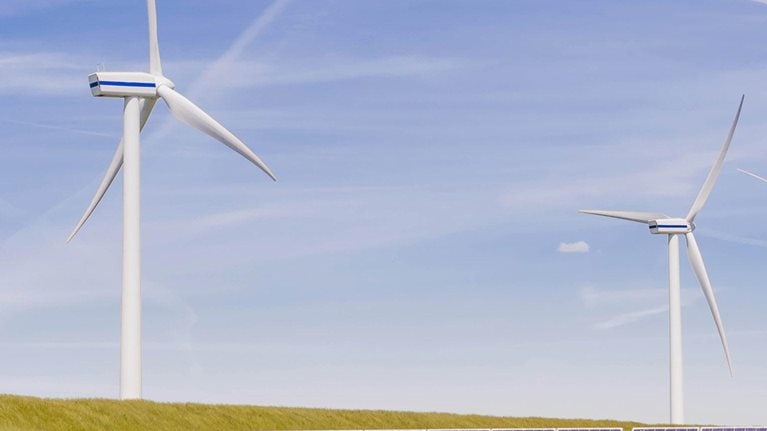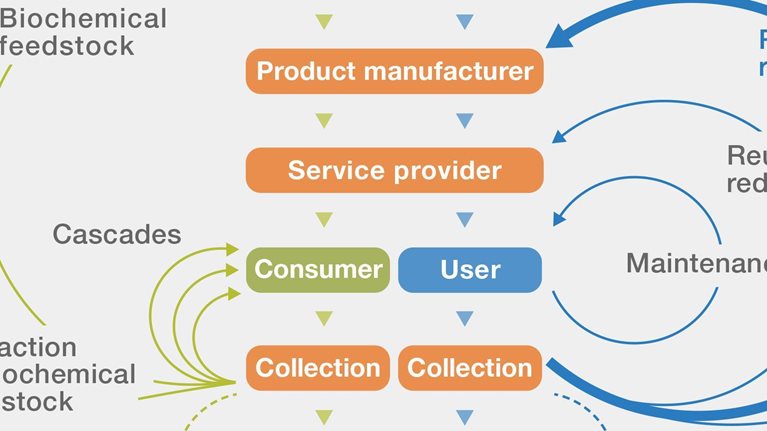Contrary to popular thinking in various companies, the circular economy isn’t the latest sustainability fad and shouldn’t be thought of as a recycling or green program. It requires top-down management and change across a company, including reevaluating product design, business models, and the supply chain. In this episode of the McKinsey Podcast, McKinsey partner Eric Hannon and senior partner Clarisse Magnin explain what the circular economy is and how companies create loops throughout to recapture value that would otherwise be lost.
Podcast transcript
Josh Rosenfield: Hello and welcome to the McKinsey Podcast. I’m Josh Rosenfield, an editor with McKinsey Publishing. In this episode, we’ll be talking about a concept known as the circular economy and how it can help companies get much more value out of the energy, materials, and other resources they use. With me is Clarisse Magnin, a senior partner in McKinsey’s Paris office, who is a specialist in supply-chain management and the retail business. Welcome, Clarisse.
Want to subscribe to The McKinsey Podcast?
Clarisse Magnin: Hi. Delighted to be here.
Josh Rosenfield: We also have Eric Hannon, a partner in the Frankfurt office, who works on product development. Eric, thanks for joining.
Eric Hannon: Thank you for having me.
Josh Rosenfield: The idea of a circular economy has been around for years, but some listeners might not know what it’s all about. So what’s a circular economy?
Eric Hannon: It’s probably easiest to understand a circular economy if we first juxtapose it with our traditional linear economy. Our traditional linear economy consists of a simple linear value chain—things like source, design, produce, consume, and dispose.
And even though, over the past couple hundred years, we’ve squeezed an extreme amount of efficiency out of that linear supply chain, it still contains a seemingly incredible amount of waste. Essentially, at end of life, we either dump everything into landfills or incinerate it.
That destroys nearly all—or the entire—value that was created in those previous process steps. A circular economy answers a simple fundamental question: How can we capture more of the value that’s lost in a traditional linear system? In the circular economy, we try to find ways to create loops in that linear supply chain in order to retain that value.
I would point out a common misconception: this is not just about recycling. Recycling is the least value-capturing loop in a circular economy because it is only incrementally better than disposal. Rather, the tighter the loop, so to say, the more the original value is captured, including loops such as refurbishment or increased utilization, secondary-life uses, parts harvesting. These are all loops in a circular economy that can capture significant value much more than recycling. Even after roughly 30 years of applying lean principles across the entire value chain, there is still a tremendous amount of waste that we can capture.
Josh Rosenfield: What’s the pressure on economies and industrial systems to become more circular now? It sounds like the linear model has prevailed for decades.
Clarisse Magnin: It’s even more than decades. It’s 150 years—a very long period. There is a strong case for change that comes from major shifts in our resources and constraints in our regulatory environment; consumers are changing their behaviors, and technology enables us to do things differently. To give a quick example on the resource constraint, you have to think that three billion new middle-class consumers driving demand will enter the global market by 2030.
This is going to put a huge amount of pressure on resources, and the ease of accessing resources is going to reduce. We see a lot of volatility in most of the raw materials. The price levels and the price volatility—the world has never experienced that in most commodities.
The second thing is consumers are also changing. We talk a lot about millennials, but there is an attitude toward more access rather than ownership. That’s why people prefer to access a service as opposed to owning a product. On the supply side, we’ve seen a lot of disruption.
The last point, on the regulatory side, is that governments are getting mobilized on carbon, on energy, on waste. There are many studies showing that there’s a lot of waste in our economy, and that creates negative externalities. Governments and all stakeholders are starting to get mobilized to urge companies to change their ways of working. The good news is that technology can help on that front.
Josh Rosenfield: Are there examples you can describe of how companies that make products or that offer consumer services are starting to go circular and eliminate waste from their processes and from their systems?
Would you like to learn more about our Sustainability & Resource Productivity Practice?
Eric Hannon: There are many examples of circular-economy principles that listeners may be familiar with but are unaware that they fit within the circular-economy framework. One of the most value-retaining circular-economy levers is increased utilization.
Many of our very expensive capital assets have extremely low utilization. If we could improve that, then we’d retain significant value during that asset’s useful life. The prototypical example here is cars. Cars have a utilization of something like 5 to 8 percent.
Even when they are utilized, they are used way below capacity—roughly one and a half people in a five-passenger vehicle, for example. So the ride-sharing companies are attacking the utilization lever. The hailing companies are attacking both utilization and capacity. There are other examples, too, such as refurbishment. Industrial-machine manufacturers get back their very expensive engine cores at end of life, refurbish them, and have created a really nice market around refurbishment rather than just simply scrapping those engine cores at end of life.
Josh Rosenfield: Clarisse, what are some ways you think a company can get started in embedding circular-economy ideas into the way it works?
Clarisse Magnin: A circular economy is not just something you do on the side or one more initiative that you add into your pipeline. It should be a priority for management. It is pretty transformational by nature, so it requires involvement from the top.
The second thing is that the circular economy should be seen as a value-creation driver as opposed to an investment or an image builder. Third, it is about collaboration, partnering, and leveraging your ecosystem to find creative solutions. It is not usually what companies are the most comfortable doing. And it takes embracing a different operating model to implement these type of solutions. There’s a need to raise awareness and communicate about the initiative to employees, to suppliers, to clients, to all stakeholders in order to educate people about the concept. As Eric was explaining at the beginning of our conversation, it’s not that complicated to understand the concept of the circular economy, but people tend to understand it only as being about recycling. Obviously, when you understand the circular economy as being only about recycling, you struggle to see it as a value-creation driver across the different steps of your value chain.
It is a transformation journey. It’s going to take a bit of time, and it’s going to take effort. But that’s not a good reason to wait two to three years to start to work toward seeing some impact.
Eric Hannon: I’d like to stress your third point because it’s a really important one, which is the ecosystem factor. A unique feature of implementing circularity is the truly cross-functional nature of the activity.
I know we say that lots of things in a company need to be cross-functional, but this is especially true here. When we’re asking people to move toward a circular model, we’re asking them to change product design, change their business models, change the way their supply chain is set up. You have to have all those people at the table working together to make that happen. We had a client whose sales team was trying hard to break into emerging economies, but the price point of their product was simply too high.
By working cross-functionally with R&D, they realized that, with some design changes, they could remanufacture end-of-life products from their home markets. And with it, they could reach the right price point they were aiming for in emerging markets. This opened up a whole new market for them, applying these circular levers. Neither R&D nor sales would’ve been able to successfully reach this market on their own. It was only by the cross-functional collaboration, trying to implement circular levers, that they were able to unlock this value.
Josh Rosenfield: Eric and Clarisse, are there particular management disciplines or operating processes that you think need to change the most in order for companies to go circular, so to speak?
Clarisse Magnin: There are a few things, and I’m sure Eric will have other ideas. It should be a transformation that is anchored into the business. We need the CEO or the CTO, the transformation officer, to be fully supportive and even maybe lead or be part of the steering committee of initiatives that will be launched on the theme of circular economy. If you leave it to the sustainability function, you really take the risk of adding yet another sustainability initiative, as opposed to making it the real source of competitive advantage and business continuity, in addition to having a greater impact on the environment and a lot of the negative externalities that companies should work on. I would think about the incentives. It should be part of the incentives of the top management to go circular.
Eric Hannon: I would echo especially your first sentiment, Clarisse. We’ve seen this quite a bit already. Very often, when a company learns about the circular economy, its executives ask the sustainability officer to figure out a few circular levers. That’s just not sufficient. What we’re doing is, when we’re implementing a circular-economy business model, we’re asking the company to do a fundamental transformation, which means questioning their business model, questioning the requirements around their product design, questioning the way the supply chains work. That’s not something that takes place in a sustainability office. Rather, that’s driven from the top down.
Clarisse Magnin: The element of innovation is also very important. The circular economy somehow profoundly challenges the way companies operate. If you genuinely want to rethink the different steps of your value chain—I’m working a lot in the consumer-packaged-goods sector and in the retail sector and in food service.
You really have, from the field to the fork, upstream sourcing practices and agricultural practices. You have the supply chain. You have the transformation. You have the downstream logistics. And you also have the way you market the products: the way you communicate the origin, the benefits, the quality of the product. I’m giving you this example because I am truly convinced that there is a lot of innovation to be found in each step of the value chain. But, obviously, it is more difficult and substantive. That’s why we talk with Eric about building competitive advantage and creating value. It’s not being incremental and just doing a bit more of what you’ve done in the past that’s going to make you transform your value chain. That’s what we are excited about, and that’s why it is a bit difficult. But I think this is where the upside will come from.
Eric Hannon: Yes, we see the need for innovation—not only in the product but along the value chain. Some of the most successful implementations we’ve seen of the circular economy so far are when the business model itself is fundamentally changed and innovated.
Great examples here are the transition from product to service in a lot of industries. Product-as-a-service examples would be instead of buying tires, you buy kilometers. And instead of buying a jet engine, you buy hours of time in the air.
What those types of models drive is a rethinking of how durable your product is, what you do with the product at end of life, what value is left in it, what value you can capture, and how you maximize that value over the entire cycle. By innovating your business model, you push the circular-economy principles throughout the rest of the organization.
Josh Rosenfield: It sounds like there’s a lot of value that companies can capture by getting all their departments and functions on board with the idea of moving toward circular business models and rethinking their processes along those lines. Once they’ve begun that journey, what are some of the obstacles they’re likely to encounter? How can they work around those, in your experience?
Eric Hannon: I’ll start with a tangible, practical example, Josh. Very often we see when we’re trying to implement circular business systems that reverse logistics is a huge operational hurdle. What we mean by reverse logistics is when a product reaches end of life and we say that it retains a lot of value and we want to capture that value, we need a way to get that product from the consumer or the business user or the customer.
We need to get that product back into our possession. There are very few supply chains that are set up with robust reverse-logistics networks, so we need to make sure that by whatever circular-economy levers we’re applying, we’re generating enough value that we overcome the additional challenges, the additional costs associated with implementing those reverse logistics.
Clarisse Magnin: Building on Eric’s point on the obstacles, they come from the fact that it is difficult because it is cross-functional. It requires realigning the incentives on a different set of key performance indicators (KPIs) and it starts with the top management, meaning, they should have sustainable value-creation KPIs in their performance dialogue and assessment. Then, number three, it is because this is often considered another sustainable initiative, while it should be, once again, a value-creation transformation for the greater good, but also, in economic terms, something that is going to bring a lot of value through savings and through revenue upsides, as well as business continuity or risk mitigation.
Josh Rosenfield: Clarisse, you just mentioned a few of the benefits that companies can realize if they shift their businesses to become more circular. Where do you see the biggest near-term opportunities, whether by industry, product category, or even by geography?
Clarisse Magnin: Before answering your question on industries and sectors, I would say that the opportunity is to be found along multiple dimensions, both costs and revenue. So there are lots of cost reductions that can come from material savings, reduced price volatility, and reduced need to duplicate value-adding activities.
There is a big cost component in value creation, but there’s also a lot of revenue upside that can come from secondary sales. It can come from an increased service portfolio but also from simply having closer and more frequent customer interactions. I also believe that consumers are becoming much more sensitive to quality, to origin, to sourcing practices, to company practices. There is also a side to think of in the way products and services are valorized when they have been produced or developed in a different way. I would like to insist on those two dimensions, costs and revenues, because this works for most industries across the globe.
Now, in terms of sectors, we did this work with Eric to go through thinking about consumer-goods companies but also IT services. All the transformation companies, obviously, because they tap into resources. They do transformation, therefore they are using energy. They are often using water, and they are generating waste. But frankly, there are very good examples of companies beyond consumer and automotive, in IT services. The examples of the reverse logistics that he gave works very well with servers and works very well with different types of equipment that companies that provide services can think of.
It does apply across sectors, and then from a geography standpoint, emerging markets start to get organized. They tend today to have less strict regulatory practices, but I think local stakeholders—including nongovernmental organizations, and sometimes it’s not the government but it’s the state or the district or the municipality—they are all getting organized. Therefore they are also creating a case for change for companies, both multinationals and local companies.

Toward a circular economy in food
Eric Hannon: When I think about your question very specifically from the geography dimension, Josh, in Europe, we see a regulatory environment is probably going to lead to a much quicker adoption of circular-economy levers than in other areas of the globe, especially from the consumer side.
First of all, there’s been a long history of legislation about taking back end-of-life products and e-waste and things like that. Up until recently, there’s even been very specific circular-economy directives coming from the EU Commission that industries will have to respond to.
The regulatory environment is tightening and will push a lot of this onto companies. When you look at a more B2B environment, China has for a long time been pushing circular-economy principles in its B2B business and their B2B industries but has not yet addressed the consumer environment. So we’re seeing a legislative landscape that is going to maybe accelerate the adoption of circular-economy principles in certain regions faster than others.
Josh Rosenfield: That sounds like a good note to finish on as we think about the prospects for the circular economy in the future. Thanks very much, Clarisse Magnin and Eric Hannon. This has been a fascinating conversation.
Eric Hannon: Thank you.
Clarisse Magnin: You’re welcome. Thanks for hosting us.
Josh Rosenfield: And thanks to our listeners for tuning in. To learn more about the circular economy and to find other episodes of the McKinsey Podcast, you can go to McKinsey.com.


